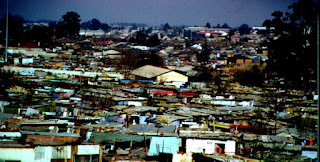Also known as Jozi, Jo'burg, or eGoli, Johannesburg is the largest city in Africa (by population). As I mentioned in an earlier post, Johannesburg is located in the province of Gauteng, and is the capital of said province. I was very surprised to learn that it is one of the 50 largest metropolitan areas in the world. It also claims the title of "World's largest city not situated on a river, lake, or coastline". It is the seat of the Constitutional Court, but is not one of South Africa's three capital cities (which are Cape Town, Pretoria and Bloemfontein). And, perhaps most importantly to me, it is served by the O.R. Tambo international Airport, which is the largest and busiest airport in all of Africa. I will be arriving there on March 31st, 2012.
Johannesburg was officially declared a city in 1928, but it all began 42 years earlier when gold was discovered. After this shiny discovery (any Firefly fans out there?) President Paul Kruger declared the area open for public digging on September 20, 1886. The city grew very quickly, morphing from tent town to wood and iron shacks, to brick buildings. At this time, Johannesburg was a classic mining town, rough and disorganized and populated by white miners from other continents. African tribesmen were recruited to perform the unskilled mine work. The origin of the name is surrounded by controversy (ohhhh drama), because there were quite a few "Johannes" walking around.
The city kept up with Paris and London in terms of new developments - at the end of the 19th century, it boasted of electric lighting, motor cars and telephones. Building developments really began to take place in the 1930s. Hillbrow, the inner city residential neighborhood of Johannesburg, went high-rise in the late 1940s and early 1950s.
In the 1950s and early 1960s, the apartheid government constructed the townships that became known collectively as Soweto. Soweto was created by the increased eviction of Africans, who were originally drawn to the city to work in the gold mines, by city and state authorities. It wasn't until 1948, when the Afrikaner-dominated National Party implemented apartheid, that the pace of forced removals and the creation of townships outside of "white areas" really increased. The Soweto Uprising occured in 1976, when mass protest erupted over the government's policy to enforce education in Afrikaans rather than English. The police opened fire on 10,000 students marching; the first victim was a 12 year old boy. If you can believe it, Soweto was not incorporated into the city of Johannesburg until October 2002.
 |
| Soweto |
Johannesburg should also ring a bell because it hosted the 2010 FIFA World Cup final at Soccer City. Just as a warning, I will probably write an entire blog entry about the World Cup at a later date, because I am a soccer dork. There are a lot of other really cool facts about culture in Johannesburg that I may also discuss at a later date. But I'll finish up today's fact by saying that Johannesburg is considered one of the most modern and prosperous cities in South Africa.
 |
| Johannesburg Region Map |
 |
| Johannesburg |
 |
| Soccer City |
As for cheetahs, today's fact is completely random. Unlike other big cats, who often hunt by night, the cheetah is a diurnal hunter. This means that it hunts either early in the morning or later in the evening when it is still light out but not so hot. They need this early morning/late evening light because cheetahs hunt by vision rather than by scent.

No comments:
Post a Comment